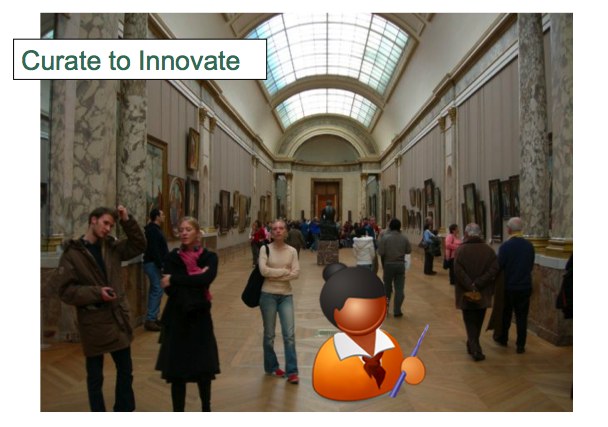I reference the concept of “curation” – something done by a content curator – a lot here on Mission to Learn as well as in other places I write and speak. So, I thought it would be good to say a bit more about what a good curator does, how to find curators, and how to be one.
First things first: What is a Content Curator?
The idea behind curators and content curation is that there is such a flood of new content pouring through the Internet and other media channels these days that being aware of all of it and sorting it out in meaningful ways is simply not possible.
Curators are people or organizations that do the hard work of sifting through the content within a particular topic area, pulling out the items that seem to be most valuable for people interested in that topic area, and eliminating less valuable items. This effort involves significantly more than finding and regurgitating links. A good curator must be skilled at:
- locating and evaluating valuable content
- sorting, organizing, and structuring content so that it is as accessible as possible
- contextualizing content to help make it as meaningful as possible to a specific audience
- creating and re-purposing content when it adds to the underlying value
- capitalizing on social networks and connections to present and share content
- building trusted relationships with learners and other curators
- monitoring and evaluating how learners interact with the content
- refining content sources and approaches to curation over time
Bottom line: A curator is an individual or organization who excels at helping others make sense.
For the individual lifelong learner, I see (at least) two powerful opportunities here.
The first is to find great curators.
If you want to combat information overload, I see this as one of the surest ways – find people who are already doing a great job making sense of the areas you care about. Some basic ways you might find these people is by:
- Paying attention to who provides the most interesting content for any newsletters or other content sources you access regularly. Does this person have a blog? Subscribe to it. (I recommend using a platform like Feedly.) A YouTube channel? Subscribe. A Twitter handle? Again, subscribe. (I recommend Hootsuite as a great tool for managing Twitter and other social media channels – though you can also pull many of these feeds into Feedly now.)
- Same as a above with speakers at any conferences you attend or books you read
- Simply search on Google, YouTube, and other major channels on topics you care about the most. If you see blogs, videos, Tweets, etc. that capture your interest, subscribe/follow.
When you first start out, you may find that you end up subscribing to or following a lot of stuff. That’s okay – you can and should pare down and refine over time, until you get to the set of curated content that is most consistently valuable to you. (Unsubscribe and Unfollow are options that need to be continually exercised!)
One additional word of advice: don’t just pick curators who seem to always be towing the same old line and writing about things you already know and believe in. Find ones that are willing to mix it up some, take some risks, and fight off homophily.
Do this all of this well and I can guarantee you will transform your learning efforts and open up new vistas.
The second is to be a curator.
If you really want to learn a body of knowledge or skills (or whatever other learning area you define), it is really hard to beat becoming a curator for that area. In a sense, this is what academics have always done. They focus in on a particular discipline and spend their lives researching, writing about, and (less and less) teaching it. The good curator does much the same, though typically in a less formal way and with no promise of tenure. (The only “job security” for a curator is in continually providing high value to an audience of learners.)
It’s not an exaggeration to say that people have reinvented their lives through this sort of effort. As just one example, I saw my colleague David Houle do this with his focus on becoming a futurist. (Notably, David is the son of Cy Houle, one of the pioneers of lifelong learning.)
Curation has become a core part of my own personal and professional learning. I give a brief overview of part of my approach to curation in my video Building Your Curation Toolbox: Feedly. I plan to create other videos in the future, but in the meantime, what about you? Who are your curators and/or what are you curating? Please comment and share.
Jeff
P.S. – Many people have written about the concept of the “content curator” or “digital curator,” but I am pretty certain I first came across it in George Siemens thoughts on curatorial teaching. Just want to give credit where credit is due.
See also:
- More on the Digital Curator
- How to Start a YouTube Channel and Grow It (Learning Revolution) – If you are interested in being a video curator. (You can even make money on YouTube.)






Content curation is a sure-shot, less-intensive tactic to gain authority without actually making an investment into content production. It works really well when you need to understand your target audience better and learn what interests them vs what they find uninteresting. I would start with a newsletter as Jeff rightly said and measure the link clicks on different posts to start getting a sense of topic interest displayed by subscribers, and then form a content strategy based on the interest levels displayed by the audience. Hope I’m making sense. My 2 cents.
Pingback: Being a Digital Curator – Learning to teach in a digital world
Pingback: Digital Information and Content Curation – DIGITAL ELUCIDATION
Pingback: Being a digital curator | taylahbriggs
Pingback: Being a Digital Curator. – beau steven
Pingback: Being A Digital Curator – Ian Connors
Pingback: Students Becoming Curators of Information? | Langwitches Blog
Pingback: Curation as a Teaching Strategy | Genius On Hold
Pingback: Digital Curator | Genevieve Stewart
Pingback: Teaching in a digital world | teachinginadigitalworldcurtinstudent
Pingback: Being a digital curator | hoipolloinetwork
Pingback: Reflection 3: Digital Curators | Teaching in a digital world
Pingback: Being a Digital Curator | Belinda Fauntleroy
Pingback: // Digital Curators and Gardens // Restrictions and Filters on online content | Katrina's Spin
Thanks Jeff, Good writing with Good examples.
Pingback: The Content Marketing Danger Zone – and How to Manage It
Pingback: myP2Ptv.info » Why Curation Will Transform Education and Learning: 10 Key Reasons
Pingback: Curator: Another hat to wear « Learning Journal
All human civilization was enourmously accellerated by three smudges of charcoal on a flat rock in Central Africa between 70,000 and 50,000 years ago. Yet, Western historians are not willing to take suggestions from African oral historians. That’s the homophily of Western culture!
So, how can I find a web curator who knows about this?
Hi Jeff,
I’m wondering how organizations that want to maintain a social presence go about recruiting content curators? Are there known practices / channels through which this happens presently?
Seems the biggest benefit is the high level of content. I see more interested and well researched content lately from more sources than ever.
Pingback: Content Curation « aLearning Blog
Drew Neisser, blogging at FastCompany, adds another characteristic of a good curator: “You can’t curate for everyone, so be targeted.” A targeted approach not only allows you to focus on a particular audience, but also makes you a better curator of your chosen subject, and adds credibility.
I launched findingDulcinea nearly four years ago, as one of the first Internet curators (we reserved the URL “CuratorOfTheInternet”). We created Web Guides for 18 categories, such as health, travel, sports, finance, etc. While most of the content we’ve published is solid, it was difficult to build credibility in 18 categories. Thus, two years ago, we began to focus on education, and we’ve since curated the best information online about thousands of topics of interest to educators and students. All of it is searchable via SweetSearch, A Search Engine for Students – and educators.
Going forward, educators themselves must become the curators for the topics they teach. Particularly in social studies and English, there is a vast array of content available for free online that, if curated and presented effectively, would be vastly superior to textbooks. Additionally, the role of a qualified library media specialist is more essential than ever, and must be filled by people willing to transform themselves and stay ahead of the needs of their teachers and students.
Pingback: Re-imagining the Librarian’s Role « BiblioShock
Pingback: Marketing via Aggregation, Filtering and Curation – Tools and Resources
Pingback: Real-Time News Curation – La Guida Completa Parte 5: Le Qualità E Le Competenze Del News Curator | seotag
Imagine if mainstream media, especially newspapers, actually became curators instead of bemoaning their fate at the hands of new media.
Pingback: Real-Time News Curation - The Complete Guide Part 5: The Curator Attributes And Skills
Hi Jeff, thanks for a thought-provoking post. I like the definition of a curator as someone who “makes sense” of the content he organises, filters, edits and distributes. I would add that in today’s Web world the importance lies not only who your curators are, but the tools they have to curate this information. You could say that Blogs are static/long form curation, but that we need tools to allow individuals to create real-time curation, quickly and easily. The question “What are you curating?” then becomes a lot easier to answer as a good tool could mean that you are curating on multiple topics that are of interest to a myriad of your networks. So my question would be not only who are your curators and what are they curating, but how are they curating?
Pingback: Link Love Monthly: March — SocialFish
Hello Jeff!
Interesting article, and I agree with Eric above. A favorite curation tool of mine is the “share” functionality on Google Reader. I can follow people who I know share good information, and then I have a complete feed of new blog posts and sites which have been vetted by the folks I follow. It’s how I found THIS post! 🙂
I also curate my own info stream on nonprofit marketing, knowledge sharing and information management via Google Reader, and anybody is welcome to follow or subscribe: https://www.google.com/reader/shared/luise.barnikel
We at IssueLab definitely agree (although sometimes grapple) with the importance of content curation. Indeed, we are an online archive (aggregator) of nonprofit research, but we see so much more value and effectiveness in our projects and special collections that are much more geared toward curation. It truly is about contextualization and, in our instance, making research available and digestible to a broad readership.
Pingback: Managing the Social Learning Mess: Auto-curating content | Ben Betts is...
I could be missing the point a bit, but I personally have found that both Twitter and Facebook are excellent “crowdsource” curators so long as your connections are qualified (and by that I mean no “auto-follow” or “auto-friending”). Because of the way I carefully choose my connections on both those platforms (two completely different groups, very little overlap), I get exposed to some really unique and quality items from around the interwebs.
Joe – Thanks for the comment and the example. I think this model definitely has legs for any org or individual that has a good enough e-mail database or site traffic – and/or dedicated fans. One of the other models I’ve seen crop up – and I think you have noted this before over on ASAE’s blog – is membership sites that pull together intensive learning/content experiences in a focused topic area and charge for people to join the community. Of course, there is also a lot of value simply in staying in ongoing contact with your community/ customers by providing quality content and interaction around. I think ASAE does a good job of that on Acronym. – Jeff
Pingback: associationjam.org
One great (and really simple) example of how to turn content curation into a potential money maker is Harvard Business Review’s “Daily Stat.”
See https://web.hbr.org/email/archive/dailystat.php
Every day, they quickly summarize an interesting piece of new research or data and link to it. Then, immediately below it, they highlight a related resource from HBR that readers can purchase. Below that, there’s an advertisement (an in-house ad in this example, but it certainly could be sold to an outside advertiser).
The “get traffic on our site” model isn’t very complicated or innovative, but it works.
Amen to that, Janet! Curation generates a lot of value, but at least for the time being, that doesn’t necessarily translate (directly) into cash in the bank. Thanks for commenting. – Jeff
Pingback: Splash: A Blog from MemberClicks » Blog Archive » Friday Top Five: The content conundrum
I think being a curator is the most interesting and rewarding part of my job. Now if I could just find a way to get paid (well) to do it.